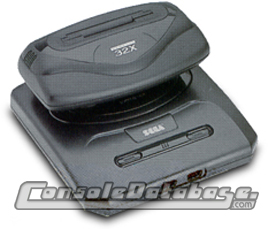![]()
http://www.consoledatabase.com


After the release of the Nintendo's Super NES, Sega needed to act fast to ensure they remained number 1 in the console market. First, they produced the Mega CD/Sega CD add-on for the Mega Drive/Genesis, which was not as successful as they had hoped. Sega had a number of other projects under development simultaneously. This was the planet series as all of these consoles were code-named after planets. Some of these were using current Mega Drive/Genesis and Arcade technology, and some used completely new technology.
Project Jupiter is where the 32X began. It was 8th January 1994 when Sega CEO, Hayao Nakayama directed his company to produce a 32-bit cartridge-based console to be in stores by Christmas 1994. Hideki Sato and other engineers from Sega of Japan presented this idea to Joe Miller of Sega of America. The idea was simply a Mega Drive console with more colours and a 32-bit processor. Miller didn\'t like the idea, saying it would be better to produce an add-on for the Mega Drive/Genesis instead. So the task was given to Sega of America to design. This was code-named Project Mars.
Meanwhile in Japan, they were working on the 32-bit CD-based system, the Sega Saturn. Sega of America were not informed about the Saturn until Project Mars was well under way.
The video game community first heard about Project Mars in mid-1994 at CES in Chicago, Illinois. When combined with the Genesis, the two would be far superior to the SNES. This amazed gamers. The official unveiling of the console (and its new name, the 32X) was at a Gamers Day held by Sega of America in late September 1994. The projected price would be US$170. A huge advertising campaign followed.
The 32X was released in mid-November 1994 in America for US$150. Japan got the console in December and Europe and Australia received it in January 1995. The system would not only play its own 32-bit cartridges, but would also act as a passthrough for existing Mega Drive/Genesis games, so that the add-on could remain permanently attached to the Mega Drive/Genesis. The 32X uses the Mega Drive/Genesis to help with game rendering. It came with a spacer so it could be attached to both models of the Mega Drive/Genesis, and 10 coupons came packaged with the console. Of course, there would be problems…
Only half a million consoles were produced to begin with, but millions were ordered. There were some programming problems too and games were rushed to meet demand. Some people complained that the 32X would not work with their model of Mega Drive/Genesis or TV and so adaptors had to be given out. Over 1994-95 it was Star Wars Arcade that saved the 32X. If it were not for this game, there would not have been as much interest in the 32X and most people would have gone with Nintendo's console and their latest game Donkey Kong Country that posed a great threat to Sega.
After so many problems with the 32X, Sega was getting a bad image. Games were not as good as expected and so Sega suffered bad publicity, which made matters worse. Customers felt cheated. As a result, Sega announced to release the Neptune - a combined Genesis and 32X that would overcome these problems. But by the time a prototype had been made, it was time to release the Saturn, and so it was cancelled.
By the second quarter of 1995, many of Sega's licensees were giving up on producing for this near-dead system and would rather produce for a real 32-bit system like the Saturn (although the 32X was as 32-bit system, the games were still mostly 2D and didn't show the power that could be produced with 32-bit technology). Gamers, too, preferred to wait for the Saturn or Sony Playstation.
In 1996, the system had basically died all together. Sega had discontinued support for it. The 32X was not a good move for Sega. It was simply a gap filler between the Mega Drive/Genesis and the Saturn. It wasted Sega's money and gave them a bad reputation, which could be why their later consoles failed.
Platform: Sega 32X.
Copyright © 2000 - 2024 Base Media. All Rights Reserved. Console Database is a trademark of Base Media. Designated trademarks and brands are the property of their respective owners. Use of this Web site constitutes acceptance of the Base Media User Agreement and Privacy Policy. Our other sites: Deals United - Daily Deals Aggregator and WhichPlug? - Travel Adaptor Finder.